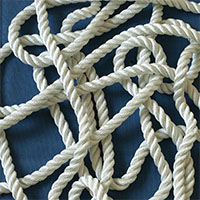Some boats are violently yawing at anchor.
Violent yawing and swinging reduce anchor holding and should be avoided.
Yawing can be avoided – I show 6 different methods to reduce yawing.
When the center for the wind forces are ahead of the center for underwater resistance Lateral centre), there will be an unstable situation. This imbalance is the basic reason for the yawing. Reducing winadage up front, and adding windage aft will help: Move aft dinghy, surfboard, canopy or solar-panels and a small “anchor riding sail” (also called steadying sail) will help.
When the boat is yawing violently (90 deg. or even more) it may “wriggle” the anchor, and loosen it, and eventually the anchor may fail completely, and then the boat will be dragging.
First I will explain the basics about “yawing at anchor”. Later in this page I will write more detailed, for you who want to “dive into this”, and I will also refer to the best books and websites, so that you can read more yourself.
FIRST – Test the theory – Turn around your boat:
When your boat is yawing violently, you have too much windage near the bow – the situation is unstable.
Test the theory – TURN your BOAT next time you anchor. When anchored from the stern, the forces have changed, and the situation will be a stable situation. You will find it works like magic.
It is perfect to test this out on a very hot day, because you will get wind into the cabin.
See my drawing – “2 methods to avoid yawing at anchor” – B: Works on motorboat (it works on any boat that is yawing)
Donald J. Jordan (inventor of the Jordan Series Drogues) wrote an interesting article about this: “Should you anchor from the stern in a storm?”
Weathervane Anchoring – Why, How, and When You Should Anchor from the Stern is a very interesting video by “RaggedyEdge”.
The easy way for sailboats to avoid yawing at anchor:
Sailboats may simply rig an “anchor riding sail”, as far aft as possible. It will also help a lot to reduce windage at the foredeck, and place the gear further aft.
Test of different “anchor riding sails” and selection of size:
Rest Easy with a Riding Sail fra Practical Sailor – af Darrell Nicholson.
Very good article on how to use an anchor riding sail:
Quit horsing around by Steve Christensen.
Motorboats may need other methods:
“Anchor riding sail” is maybe not a practical solution for a motorboat – here the it could be practical to use 2 anchors in “V”. There are several other methods – se my drawing “BOAT YAWING 90 deg”.
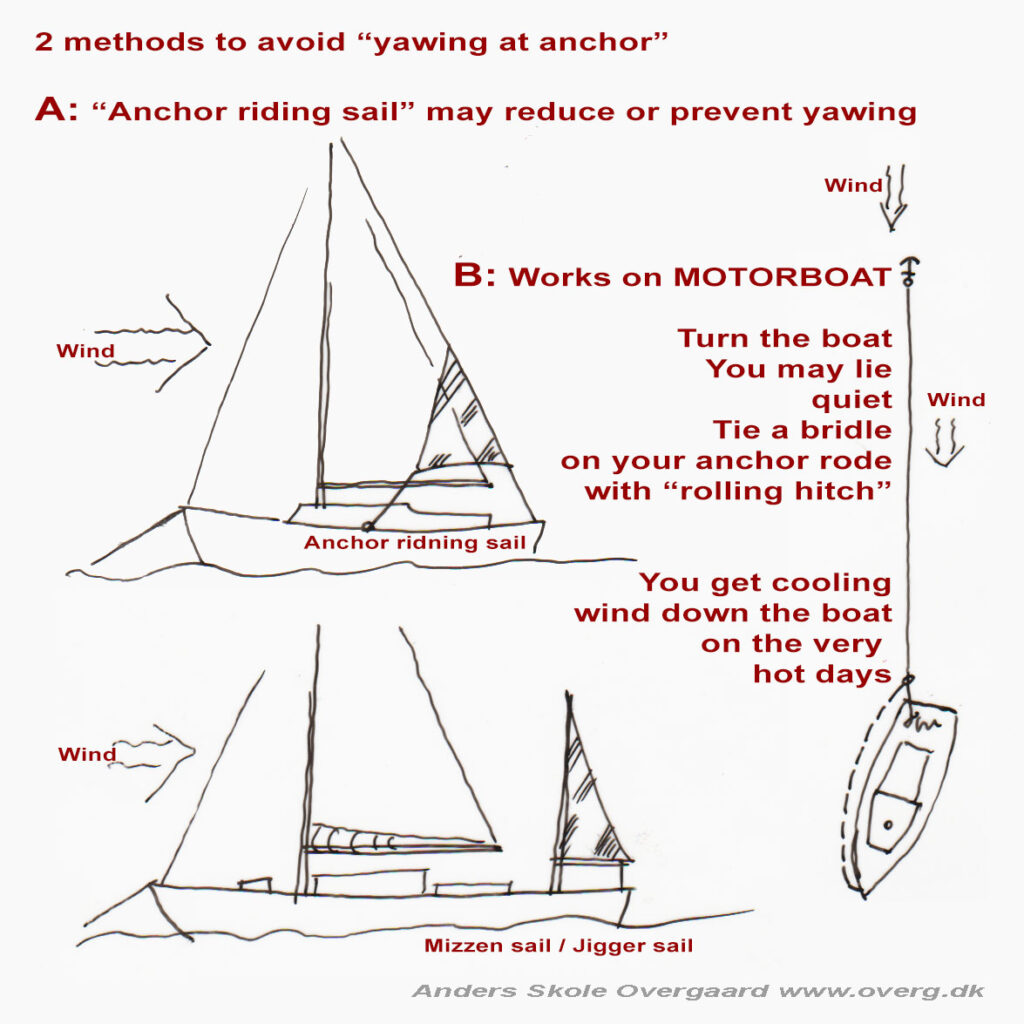
The laws of physical are relatively simple
The main reason for yawing violently is, that the forces create an unstable situation: Center of the windforces are ahead of the center of forces underwater (underwater lateral center) – and the anchored boat is NOT in balance.
This is similar to shooting an arrow without feathers, the arrow will NOT fly straigth.
The consequence of the constant yawing back and forth every few minutes, is much higher load on the anchor gear, and the shifting direction of pull may loosen the anchor, and eventually the anchor may start dragging.
Fraysse writes that wind forces may double or more, when the boat is “tacking” and turning around – read on his website RODE FORCES.
Fraysse also mentions that the anchor will be pulled and yanked in changing directions – and this may loosen the anchor.
Read here: 3. Yawing and Swinging Consequences.
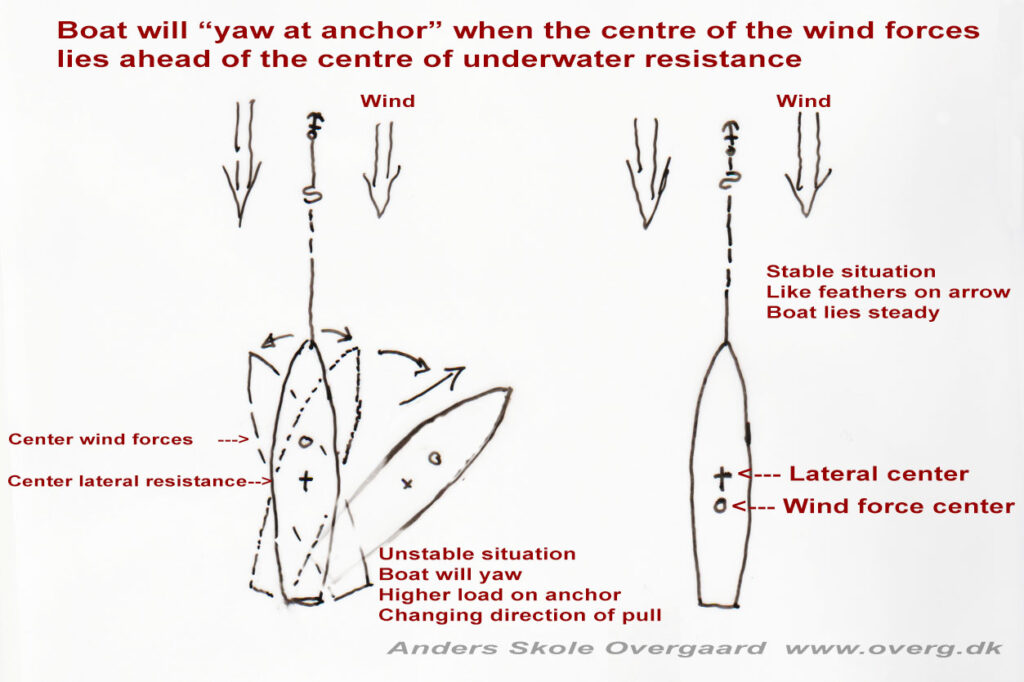
Definitions by Fraysse:
Yawing is rotation around verticl axis.
Swinging is the almost cirkular movement around the anchor, caused by yawing.
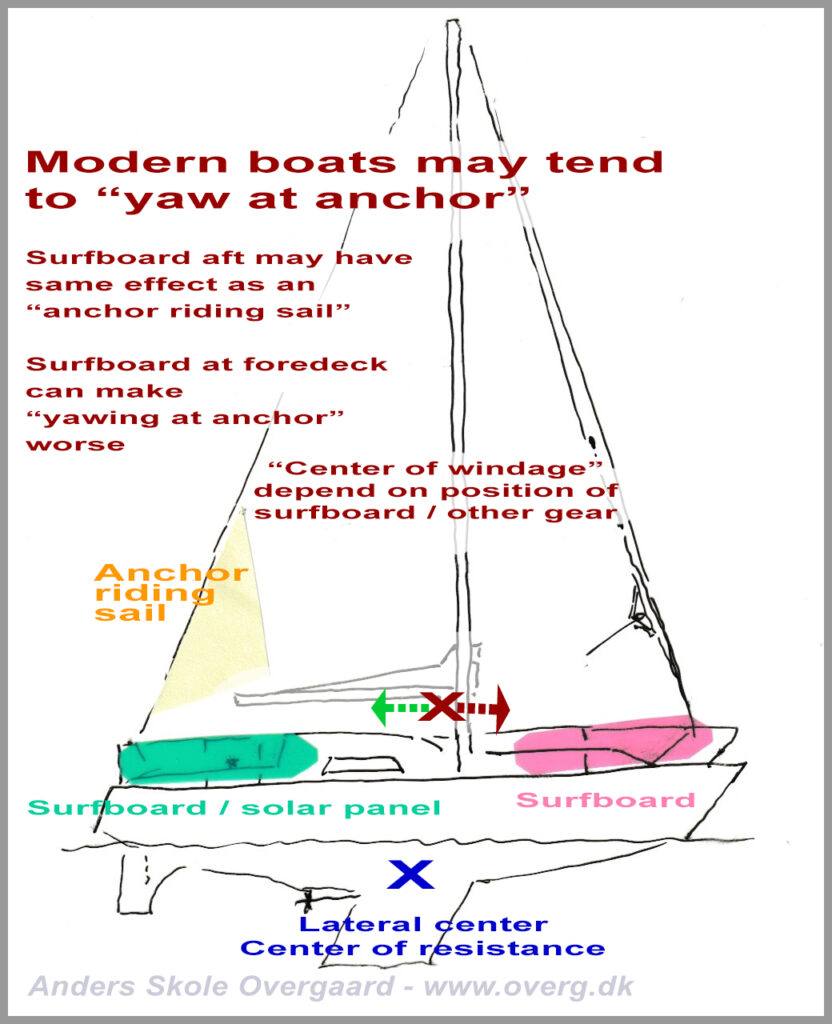

Drawing: BOAT YAWING 90 deg
Several ways to reduce yawing at anchor:
Turn the boat:
On very hot days this is a great way to get cooling ventilation through the boat.
Use an “Anchor riding sail”:
Reducing windage at front and adding windage aft will help: Move away gear from from the foredeck, and put it further aft, may help: Dinghy, surfboard, canopy or solar-panels and any small “riding sail” will help.
Lay out an extra anchor in ”V”:
Use two anchors at an angle of 60 – 90 degree – then you will be steady.
Your “Extra anchor” does not need same size and may have shorter scope. Eventually “hammerlock”.
Lie at an angle 30-45 degrees:
Use an bridle from anchor rode to the stern, so that you position the boat with an angle to the wind of app. 45 deg.
The boat will go to one side and keep steady at an angle. Wind pressure will be higher but constant, and anchor will NOT be wriggled from side to side.
Use a cross-boom and 2 bridles:
Your boat will now be anchored like a katamaran/trimaran with 2 long bridles and the load from anchor to both hulls. I tested this idea myself – and it woorks GREAT – Your boat will lie SURPRISINGLY steady.
Change the underwater resistance:
Change of the underwater lateral area will also influence the balance of the forces working on the boat.
This last idea may seem very theoretic – BUT cats and trimarans CAN experiment with daggerboards and rudders.
I never got this to work, but you can make your own experiments with a drogue on the anchorrode as described by Drew Frye: Twisting in the Wind
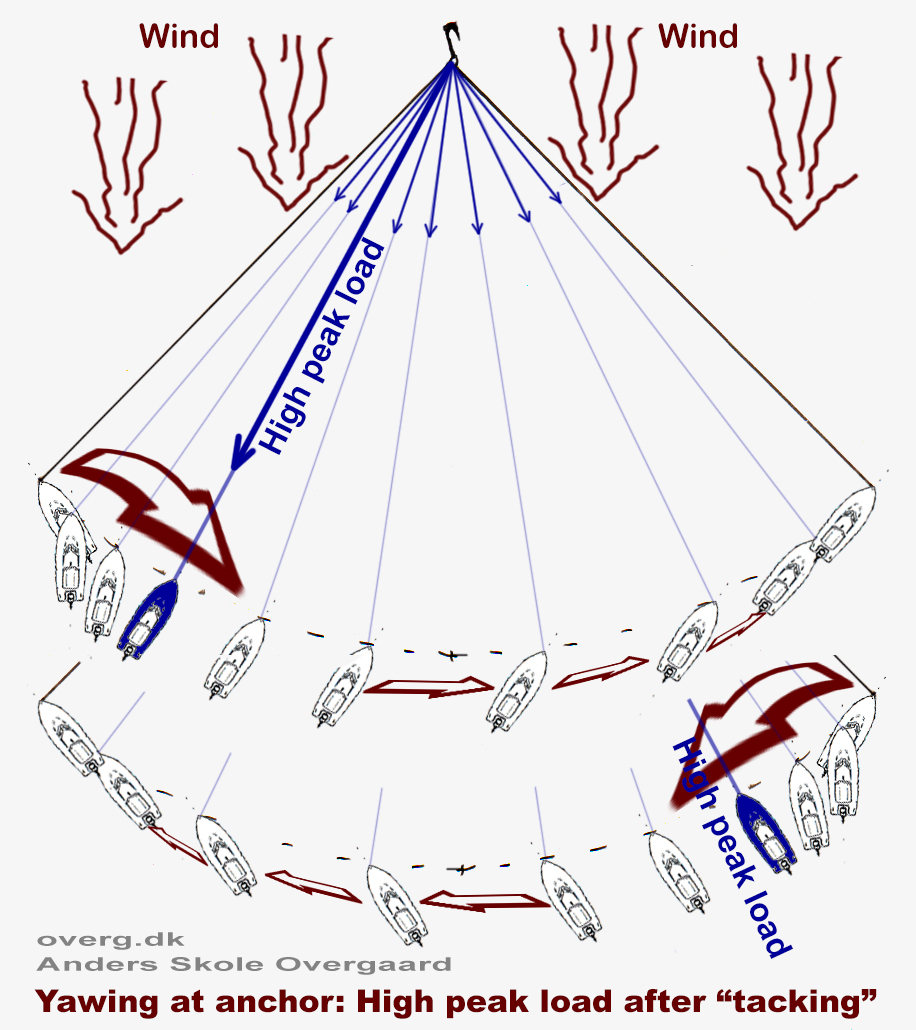
by wriggeling and peak loads
Steady direction of the pull, will help your anchor to do its job:
You can help your anchor to create the best possible hold in the bottom material.
Avoid “yawing” at anchor, because the constant change of direction of the pull every few minutes may “wriggle” the anchor, so that the bottom material may be worked loose.
There are also peak loads, when the boat is gaining speed just after “tacking” – in high winds these peak loads may be 3 x normal load.
When the material around the anchor constantly is disturbed – called “liquefaction” – the anchor may reduce its hold in the bottom material, and even completely loose the grip.
In the worst case, the boat may be dragging with the anchor.
This is described in detail by Drew Frye, read his article: Yawing and Anchor holding. He describes how anchors can “shuffel” along the seabottom for longer distances.
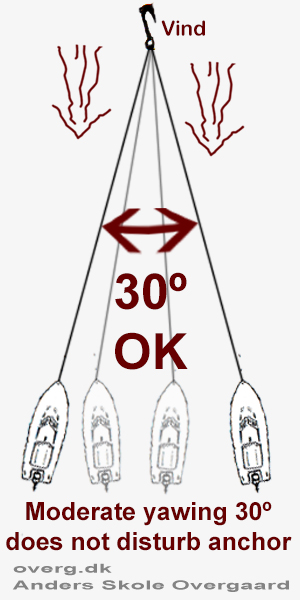
If you want to “dive into this”, here comes more details about “yawing at anchor”:
I have now explained the most important about this subject, and you may quit the rest. Return when you have time and are curious about more details: I will refer to some good sources – books and websites, where you may study this more. I will also explain more about my own experiments with some of the methods to lie steady and AVOID yawing.
Drew Frye writes, that “yawing at anchor” probably is a very common reason for boats dragging:
Drew Frye observe in his tests, that …”yawing less than 30 degrees typically has no significant effect on holding capacity.”… of the anchor.
Drew Frye observe in his tests, that when the boat is yawing violently 90-120 degres, it will loosen the anchor, Read his article: Yawing and Anchor holding.
In the many tests they have a diver in the water to observe, and this is what happens:
- …”When first set, the shank is buried in compacted earth”…
- …”after just a few yaw cycles, the shank finds itself in tilled earth with no ability to resist rotation.”…
- …”Combined with liquefaction of the soil around and in front of the fluke, the force required to cause rotation and walking drops 30 to 60 percent after 2-3 cycles.
- Then the anchor starts “shuffling” – and will slowly move along.
- Drew Frye observed many times in his tests, that 10-30 minutes of yawing could make the anchors fail completely.
He writes more: …”And so, we believe that just behind poor anchor technique and impossible bottoms, yawing is probably the leading cause of dragging.”…
“Short scope is murder” skriver Drew Frye: The combination of short Scope AND yawing makes the anchor hold extremely little.
The yawing increases the load, and reduce the anchor holding so much, that he also concludes this:
…”If you can reduce yawing to less than 30 degrees with a riding sail, bridle, or other adjustments, that’s like doubling the size of your anchor.“…
Maybe the best book about anchoring:
“Creative Anchoring” af Fatty Goodlander. He writes page 59:
“Two Anchors Easy Peasy!”
…”The best way to increase your level of safety from dragging during a storm is to deploy two anchors with two separate rodes from your bow – at an angle of 60 degrees from the worst wind direction.”…
Fatty Goodlander is strongly recommending at page 193, a “keep away anchor” like this:
- Danforth galv. steel 5 kg
- 5 m. 6-8 MM chain
- 75 m. 10-12 MM 3-strand NYLON rope – the most elastic synthetic fibre polyamide.
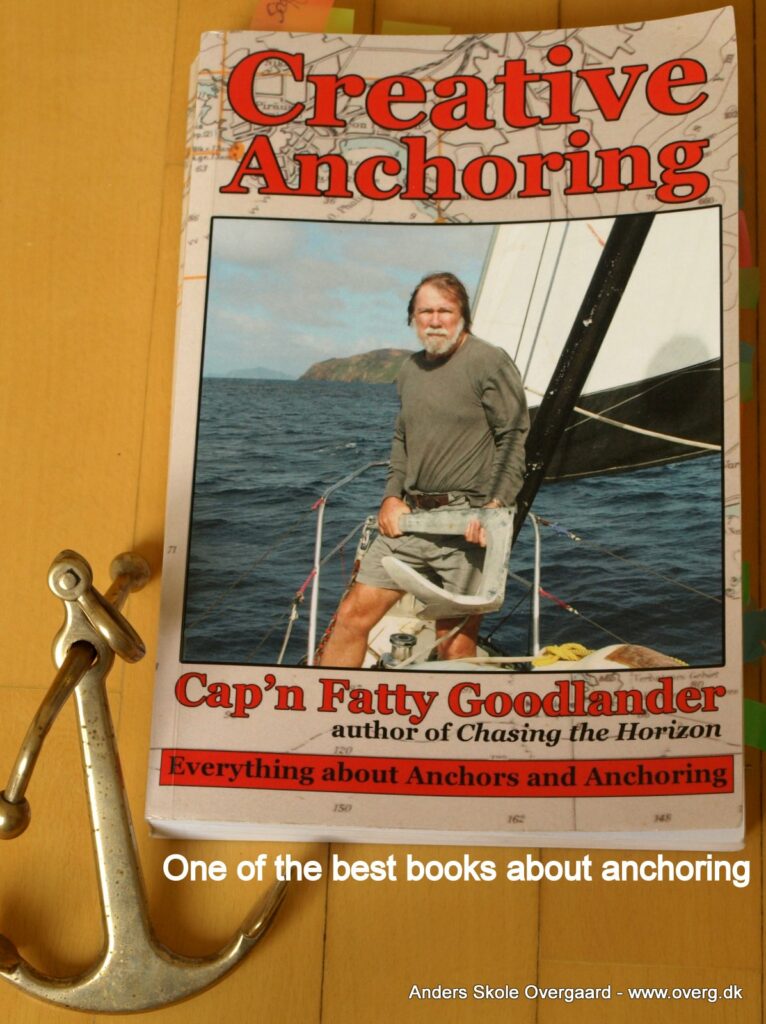
Interesting article about “Yawing at anchor”
by Drew Frye:
Read it here: Twisting in the Wind
Drew Frye tells about a catamaran yawing and how to prevent the yawing – and he tell about several methods – (the same things I have described here in my web). But I will emphasise his testing with a drogue under the bow:
I cite from his article:
Bow Drogue
We think of drogues as fabric cones that are trailed behind the boat underway in a gale to reduce speed, improve directional stability, and prevent surfing and broaching. But deployed with short scope from the bow of an anchored boat, a drogue can reduce the speed and range of yawing.
Deploy the drogue with just enough rode (length equal to about three times the freeboard) so that it can pass under the bow during a tack. Weight the tail with just enough chain to keep it in the water, but not so much that it cannot rotate up to the surface when the boat swings.
Cone-shaped fishing drogues work; about 1 inch of diameter for every foot of boat length seems about right.
A string of Davis Rocker Stoppers also works. The drogue may also be deployed from the rode, about 10 to 15 feet forward of the bow, where it will also serve to stop vertical movement of the rode (pitching).
I have personally tried to hang a Drogue under the stern of the boat a few times – BUT but without success. ASO
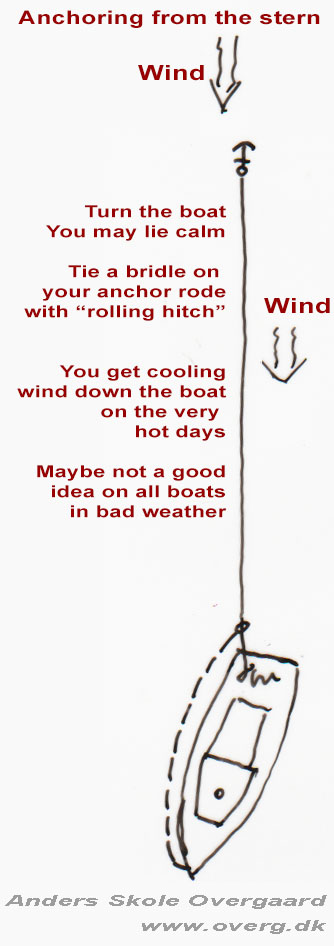
We often anchor from the stern:
Ourselves, we very often anchor from the stern, when we make a short stop to have a coffebreak og lunch. This is also the easyest way for us.
In our small boat 19 feet, it is most safe and very convenient to handle the anchor directly from the cockpit, and then it is also very easy to tie off at a stern cleat.
Anchoring from the stern makes our boat lie completely steady and calm.
This is a very good idea in warm weather and moderate wind.
BUT in cold weather with wind and waves, we have to anchor from the bow, to feel comfortable in the cockpit. Then we eventually use our extra anchor (out in V )to lie quiet without yawing.
In stormy weather some boats will certainly NOT be built to lie with the stern to the wind and waves.
Interesting article about anchoring from the stern.
Read the article: Should you anchor from the stern in a storm?
The inventor of the Jordan Series Drogues, has often used his drogues, and realised that the boat was lying very stable in the storm, with the drogues laid out after the boat to reduce the speed.
His experience is perfectly matching my own suggestion, that sailors should EXPERIMENT with anchoring their boat from the stern. Especially if you do not understand what is happening, when your boat is “horsing around” it will be a good experiment. I do believe, that you will experience a “magic moment”, when your boat suddenly lies completely steady and kalm.
This experiment will be fine – especially in hot weather, where it will be nice to have cooling airflow into the boat. Just try to “turn the boat around” – eventually use a bridle on the anchorchain/rope.
From the article “Should you anchor from the stern in a storm?” :
Fifteen years of experience with the series drogue tethered at the stern has
demonstrated that, with hurricane-force winds and even when buffeted by large, breaking storm waves, the boat will ride quietly and will quickly adjust to wind shifts and random wave strikes.
Read the article: Should you anchor from the stern in a storm?
Donald J. Jordan, developer of the series drogue, is a retired engineer and longtime sailor from Glastonbury, Conn.
Comment from ASO: BUT anchoring like this in a storm is maybe not a good idea with all boats – read some discussions at “Cruisers Forum” Discussion on anchoring from the stern in a storm.
2 anchors in “V” – a simple method wich we very often use ourselves:
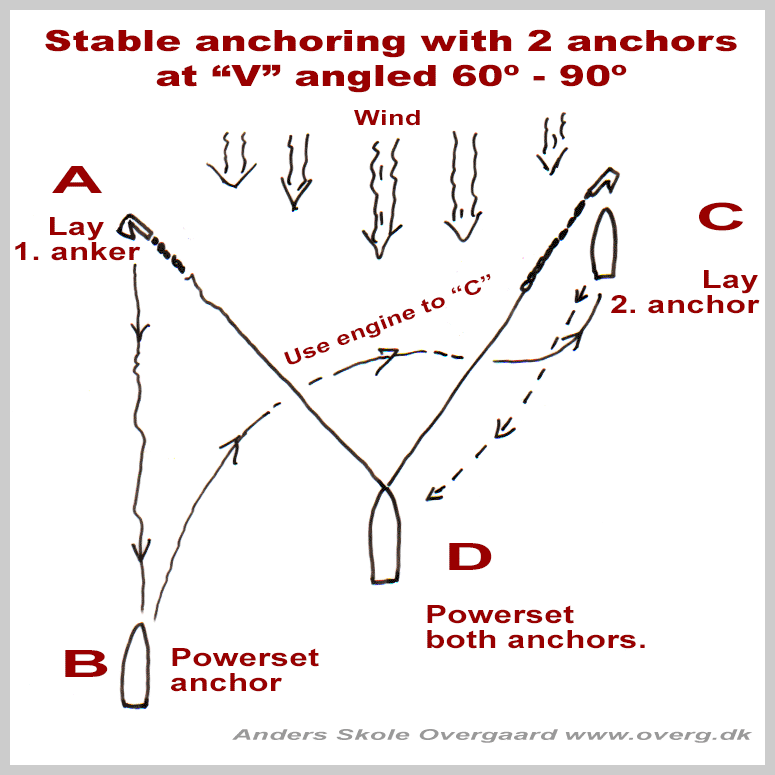
2 anchors in “V” will hold your boat stable:
On a motorboat, this method is maybe the easiest and fastest way to establish a calm and steady anchoring:
Lay out the “main anchor” as usual, and “power set” it. Then use your motorpower to change position, and lay out the 2. anchor.
It will be handy, if you use a smaller anchor with nylon rode.
Two anchors in “V” gives additional anchoring holding in bad weather, as mentioned above from the very good book “Creative Anchoring” by Fatty Goodlander.
Of course two anchors may give tangling rodes, if the wind is changing unexpected. But normally we just have to move one of the anchors, if the wind is changing.
“Joachim Schult “Das ist Motorboot fahren”:
Page 156: If you anticipate a change in the wind, you may lay out the smallest anchor with short scope. When the wind is changing, you simply pull up close to the smal anchor, and let it drag a little to follow the changing wind direction.
Your boat will move on a circle with the big anchor as a centre. And you will end up, lying with two anchors in “V” against the NEW wind direction.
Anchoring vith two anchors in “V” is debated:
Some writers claim (in Denmark), that it is impossible to anchor properly with two anchors in “V” holding power, because the two anchors are not loaded equally.
I suppose they never tried it – it works great!
And the anchors DO NOT need to be equally loaded.
My own experience “V”-anchoring:
We very often use this method. I find it simple and easy to lay out (or even throw 5-6 m away) our small “baby-anchor”. I prefer to do some extra work with this, because I find it annoing to “sail all over the place”, and don´t mind the little extra work to lie steady and calm.
If we anchor close to the beach, we normally lay the 6 kg Delta as far out as possible (eventually prolonging our anchor rope), and lay the “baby-anchor” close to the beach. Then we can position the boat on the “perfect spot” at ½ m depth, so that we easily can wade to the beach.
Our “big anchor” is Delta 6 kg with 18 m 10MM nylon rode, our “baby-anchor” is a tiny 2 kg BRUCE-copy with 16 m 8MM nylon rode. Even if the holding power of our “baby-anchor” is modest 35 kg, it “grabs” easily in sand, and it works perfectly for this use.
If we want to stay overnight in such a place (it MUST be a reliable weatherforecast), I always add a 3. long line to a rock or a tree or whatever available, so that I can turn around the boat during the night – simply by tying the anchorrode and the ropes differently on the boat.
Our boat weighs only 1000 kg, and it is rolling much too lively, if suddenly the small waves come from the side. Then I turn he boat – stern to the small waves, to sleep properly.

Anchoring at an angle 45 degrees with a bridle, is a simple and effective method to avoid yawing:
IMPORTANT: The bridle CAN get under the boat, if the angle to the wind is too small; then the boat may “tack”.
SAFE METHOD could be to lead all forces directly to a STRONG cleat on the sidedeck, placed a little forward to midship.
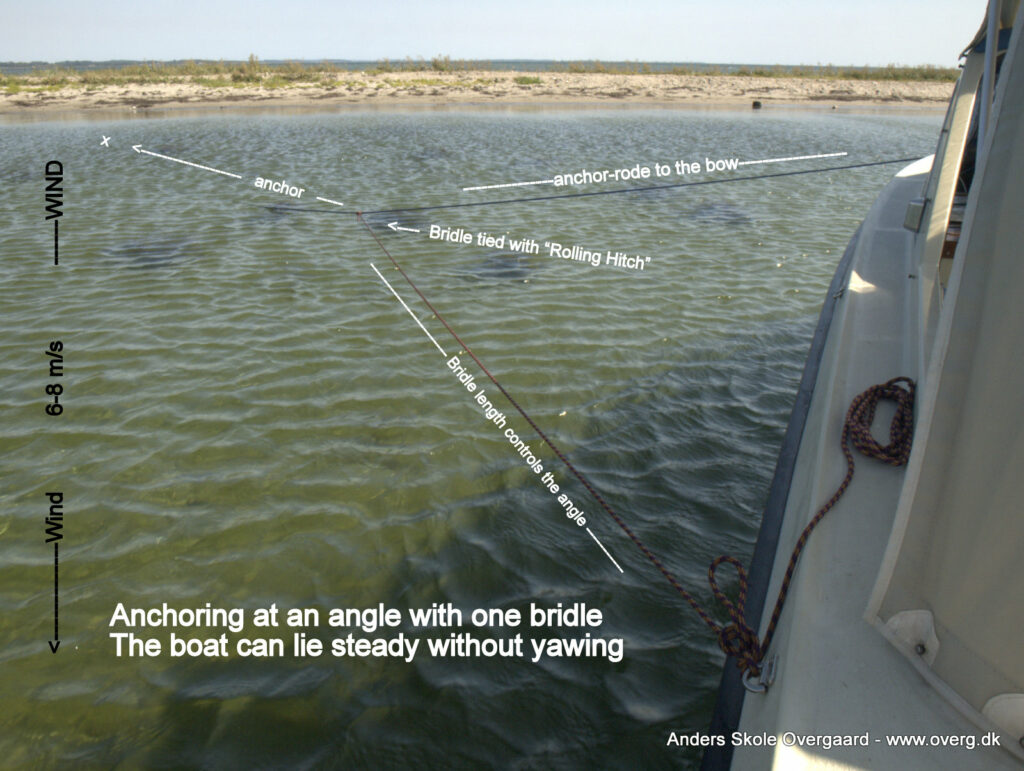
Anchoring at an angle with a bridle:
This is quite simple and effective. Adjust the length of the bridle, to adjust the angle.
Fasten the bridle on to your anchor chain with a chainhook or a softshackle, or simply tie a “rolling hitch”.
The bridle should go far aft on the boat.
The boat will sheer out to at certain point and lie stable. The windforces will be higher, because you have the boat at an angle. But the anchor holding will be very good, because the load is constant and in same direction.
This method can also be used to “angle” your boat if the waves come from another direction than the wind, and your boat rolls uncomfortably. Turn the boat – stern to the waves.
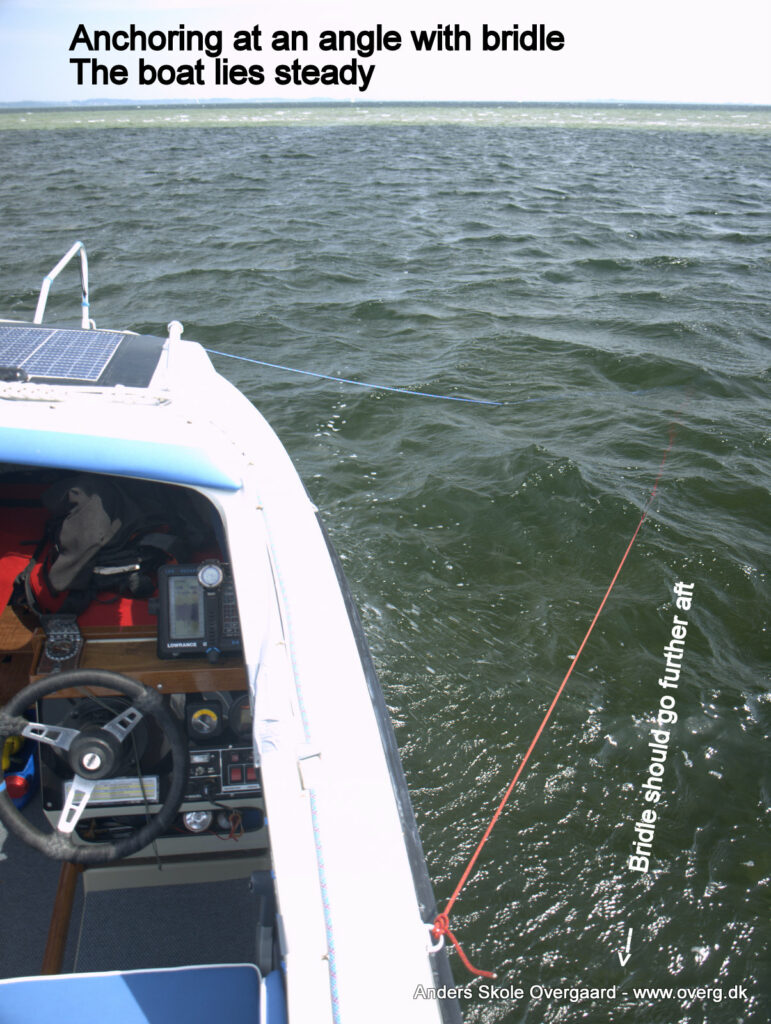
Anchoring with “cross spar and two bridles” – I tested this idea, and it did work out extremely well for me.
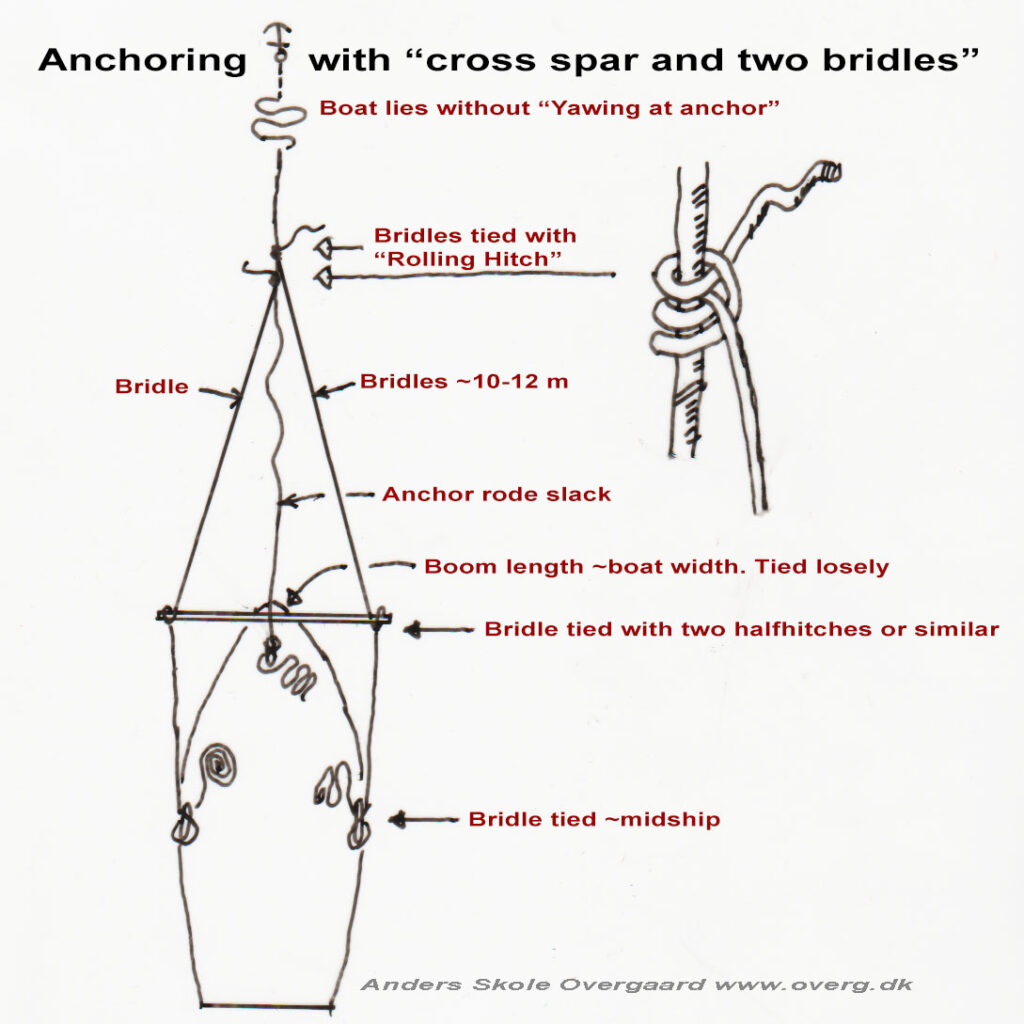
This method works – it was a great surprise to lie so quiet!!!
This arrangement creates the same situation as a catamaran (or trimaran) with bridles to the side-hulls. The bridles must have some length!!
This method gives little windage and a steady boat, so you get all the advantages.
And if the wind direction should shift, you will simply follow the change of wind direction.
The only disadvantage is that you need to rig the spar and the two bridles.
The bridles can also be the anchorsnubbers.
I suppose that this method is rather unknown – but if you do have a spar and the rope, it is worth to experiment with this method.
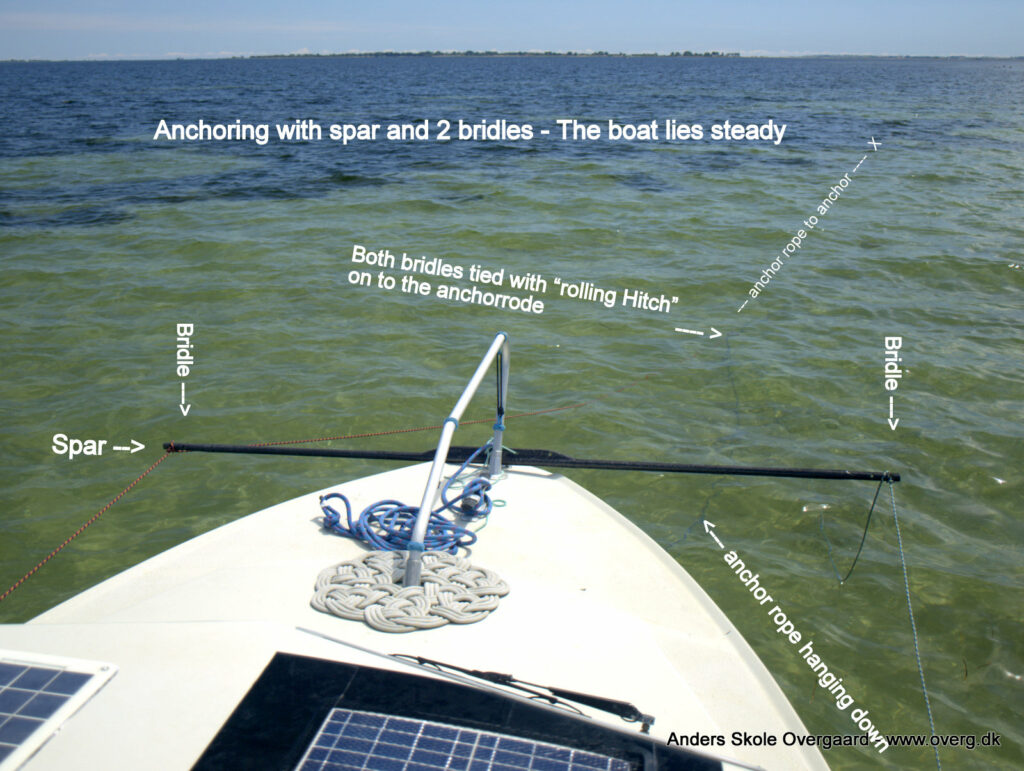
Links / webs / articles about yawing at anchor:
Very good article on how to use an anchor riding sail, and avoid yawing at anchor:
Quit horsing around by Steve Christensen.
NEW VIDEO 2025 from Steve Goodwin – the american anchortester:
Yawing at Anchor. Adding Mizzen.
This website:
My website is mostly in Danish – you can read the same content (with small variations) in Danish here: 6: Undgå ankersejle på 6 måder.
How to Make an Anchor Riding Sail Kit
An anchor riding sail helps keep your boat pointed in one direction instead of swinging from side to side while anchored… Visit Sailrite
